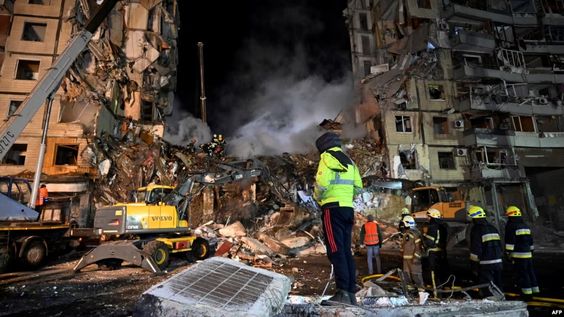Headlines
Missile strike on Ukrainian apartment building, dozens of people are dead or missing

In the southeast Ukrainian city of Dnipro, families of the missing wait outside the apartment building’s wreckage in the hope of good news as rescuers look for survivors of Saturday’s Russian missile attack on the nine-story apartment building.
According to Roman Zhuravsky, “My mother hasn’t been discovered yet.” But given that five levels collapsed above her, what are the chances?
According to Natalia Babachenko, the regional governor’s assistant, 30 people have been confirmed deceased, and more than 30 are hospitalised, including 12 who are in bad condition. According to Babachenko, there may still be 30 to 40 people buried underneath the debris.
“Around-the-clock search and rescue efforts and the removal of hazardous structural components are ongoing.” “We keep fighting for every life,” Volodymyr Zelenskyy, the president of Ukraine, declared.
The head of the Ukrainian armed forces, Gen. Valerii Zaluzhny, reported that on Saturday, Russia fired 33 cruise missiles, 21 of which were shot down. According to the air force leadership, the missile that struck the apartment complex was a Kh-22 launched from the Kursk region of Russia, but Ukraine lacked an interceptor system for that kind of weapon.
While claiming responsibility for missile attacks against targets in Ukraine, the Russian defence ministry made no mention of the assault on the Dnipro apartment complex. The building, according to some people, has little military strategic value.
READ ALSO: According to the Pentagon, Ukrainians will train on American Patriots
The ministry posted on Telegram that “all specified targets have been hit.” “The attack’s objective has been met.” It stated that “against the military command and control system of Ukraine and related energy infrastructure,” missiles were fired.
Russian-Belarusian drills
Belarus, Ukraine’s northern neighbour, is set to launch joint military drills with Russia on Monday, according to Reuters.
Since the conflict began, Belarus and Russia have engaged in a number of military drills, raising concerns in Ukraine and among its allies that Russia is expecting Belarus to join the battle on its side despite promises from Minsk that it wouldn’t.
The Belarusian Security Council’s first deputy state secretary, Pavel Muraveyko, wrote on the social networking site Telegram that “the drill is solely defensive in character.”
According to him, the exercises will include “aerial reconnaissance, diverting airstrikes, air cover of critical objects, and communications” and will last until February 1.
The UK is sending tanks to Ukraine.
A few hours after the missile attacks on Saturday, Britain pledged to send Challenger 2 tanks to Ukraine to aid in defending against the Russian invasion.
Approximately 30 self-propelled AS-90 cannons would follow the tanks, according to the office of Prime Minister Rishi Sunak. He declared that the Ukrainian army would soon begin receiving training on how to operate the guns and the tanks.
The primary battle tank for Britain is the Challenger 2. According to the army, it has been in use since 1994 and is made to assault other tanks.
In time for the spring 2023 draught, Russia may raise the age requirement for military conscription from 27 to 30, according to the British Defense Ministry. If this happens, Russian troops would be able to enlist at least 30% more people.
The British government stated that Russian President Vladimir Putin has stated his support for the measure and that “Russian officials are likely to gauge public reactions.”
The Associated Press, Reuters, and Agence France-Presse all contributed information to this article.
